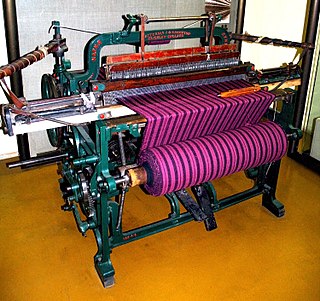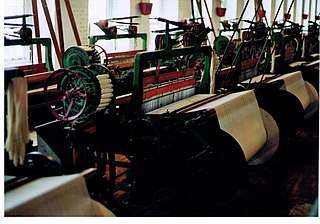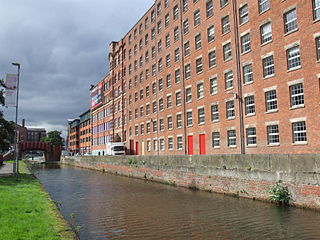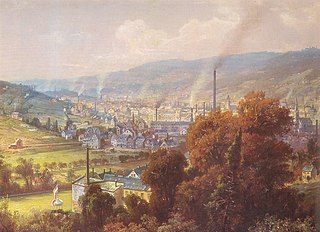Related Research Articles

A loom is a device used to weave cloth and tapestry. The basic purpose of any loom is to hold the warp threads under tension to facilitate the interweaving of the weft threads. The precise shape of the loom and its mechanics may vary, but the basic function is the same.

Weaving is a method of textile production in which two distinct sets of yarns or threads are interlaced at right angles to form a fabric or cloth. Other methods are knitting, crocheting, felting, and braiding or plaiting. The longitudinal threads are called the warp and the lateral threads are the weft, woof, or filling. The method in which these threads are interwoven affects the characteristics of the cloth. Cloth is usually woven on a loom, a device that holds the warp threads in place while filling threads are woven through them. A fabric band that meets this definition of cloth can also be made using other methods, including tablet weaving, back strap loom, or other techniques that can be done without looms.
James Hargreaves was an English weaver, carpenter and inventor who lived and worked in Lancashire, England. Hargreaves is credited with inventing the spinning jenny in 1764.

The spinning jenny is a multi-spindle spinning frame, and was one of the key developments in the industrialisation of textile manufacturing during the early Industrial Revolution. It was invented in 1764-1765 by James Hargreaves in Stan hill, Oswaldtwistle, Lancashire in England.

A power loom is a mechanized loom, and was one of the key developments in the industrialization of weaving during the early Industrial Revolution. The first power loom was designed and patented in 1785 by Edmund Cartwright. It was refined over the next 47 years until a design by the Howard and Bullough company made the operation completely automatic. This device was designed in 1834 by James Bullough and William Kenworthy, and was named the Lancashire loom.

Samuel Crompton was an English inventor and pioneer of the spinning industry. Building on the work of James Hargreaves and Richard Arkwright, he invented the spinning mule, a machine that revolutionised the industry worldwide.

In the manufacture of cloth, warp and weft are the two basic components in weaving to transform thread and yarn into textile fabrics. The vertical warp yarns are held stationary in tension on a loom (frame) while the horizontal weft is drawn through the warp thread. In the terminology of weaving, each warp thread is called a warp end ; a pick is a single weft thread that crosses the warp thread.

A cotton mill is a building that houses spinning or weaving machinery for the production of yarn or cloth from cotton, an important product during the Industrial Revolution in the development of the factory system.

Textile manufacture during the British Industrial Revolution was centred in south Lancashire and the towns on both sides of the Pennines in the United Kingdom. The main drivers of the Industrial Revolution were textile manufacturing, iron founding, steam power, oil drilling, the discovery of electricity and its many industrial applications, the telegraph and many others. Railroads, steamboats, the telegraph and other innovations massively increased worker productivity and raised standards of living by greatly reducing time spent during travel, transportation and communications.

Thomas Highs (1718–1803), of Leigh, Lancashire, was a reed-maker and manufacturer of cotton carding and spinning engines in the 1780s, during the Industrial Revolution. He is known for claiming patents on a spinning jenny, a carding machine and the throstle.

The Hat Works is a museum in Stockport, Greater Manchester, England, which opened in 2000. Before that, smaller displays of hatting equipment were exhibited in Stockport Museum and in the former Battersby hat factory.

A weavers' cottage was a type of house used by weavers for cloth production in the putting-out system sometimes known as the domestic system.

The Lancashire Loom was a semi-automatic power loom invented by James Bullough and William Kenworthy in 1842. Although it is self-acting, it has to be stopped to recharge empty shuttles. It was the mainstay of the Lancashire cotton industry for a century.

The Roberts loom was a cast-iron power loom introduced by Richard Roberts in 1830. It was the first loom that was more viable than a hand loom and was easily adjustable and reliable, which led to its widespread use in the Lancashire cotton industry.

A weaving shed is a distinctive type of mill developed in the early 1800s in Lancashire, Derbyshire and Yorkshire to accommodate the new power looms weaving cotton, silk, woollen and worsted. A weaving shed can be a stand-alone mill, or a component of a combined mill. Power looms cause severe vibrations requiring them to be located on a solid ground floor. In the case of cotton, the weaving shed needs to remain moist. Maximum daylight is achieved, by the sawtooth "north-facing roof lights".

"Kissing the shuttle" is the term for a process by which weavers used their mouths to pull thread through the eye of a shuttle when the pirn was replaced. The same shuttles were used by many weavers, and the practice was unpopular. It was outlawed in the U.S. state of Massachusetts in 1911 but continued even after it had been outlawed in Lancashire, England in 1952. The Lancashire cotton industry was loath to invest in hand-threaded shuttles, or in the more productive Northrop automatic looms with self-threading shuttles, which were introduced in 1902.
Piece-rate lists were the ways of assessing a cotton operatives pay in Lancashire in the nineteenth and early twentieth centuries. They started as informal agreements made by one cotton master and their operatives then each cotton town developed their own list. Spinners merged all of these into two main lists which were used by all, while weavers used one 'unified' list.

Harle Syke mill is a weaving shed in Briercliffe on the outskirts of Burnley, Lancashire, England. It was built on a green field site in 1856, together with terraced houses for the workers. These formed the nucleus of the community of Harle Syke. The village expanded and six other mills were built, including Queen Street Mill.
Ellen Hooton was a ten-year-old girl from Wigan who gave testimony to the Central Board of His Majesty's Commissioners for inquiring into the Employment of Children in Factories, 1833. She had been working for several years at a spinning frame, in a cotton mill along with other children. She worked from 5.30 am till 8 pm, six days a week and nine hours on a Saturday. She absconded at least 10 times and was punished by her overseers.

A Dandy loom was a hand loom, that automatically ratchetted the take-up beam. Each time the weaver moved the sley to beat-up the weft, a rachet and pawl mechanism advanced the cloth roller. In 1802 William Ratcliffe of Stockport patented a Dandy loom with a cast-iron frame. It was this type of Dandy loom that was used in the small dandy loom shops.
References
Notes
- ↑ Radcliffe was also responsible for the 1802 hand operated metal "power-loom", the Dandy loom; this significantly improved the productivity of the hand loom weaver. The Dandy loom also had automated takeup, and benefited from off loom dressing. [4]
Footnotes
- ↑ Marsden 1895, p. 50–52.
- 1 2 3 Timmins 1993, p. 19.
- ↑ Baines 1835, p. 234.
- ↑ Timmins 1996, p. 24.
- ↑ Guest 1823, p. 46.
- ↑ Baines 1835, p. 235.
- ↑ Timmins 1993, p. 20.
Bibliography
- Baines, E (1835). The History of Cotton Manufacture in Great Britain. London: Fisher, Fisher and Jackson. pp. 253.
- Guest, Richard (1823). A Compendious History of the Cotton-Manufacture; with a disapproval of the claim of Sir Richard Arkwright to the invention of its ingenious machinery. Manchester: Joseph Pratt, Chapel Walks.
- Marsden, Richard (1895). Cotton Weaving: Its Development, Principles, and Practice. London: George Bell & Sons.
- Timmins, Geoffrey (1993). The Last Shift: The decline of handloom weaving in nineteenth-century Lancashire. Manchester: Manchester University Press. p. 253. ISBN 0 7190-3725-5.
- Timmins, Geoffrey (1996). Four Centuries of Lancashire Cotton. Preston: Lancashire County Books. pp. 92. ISBN 1-871236-41-X.

